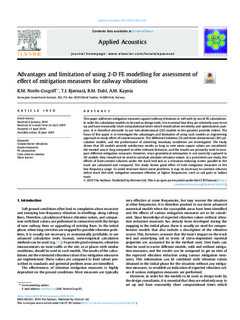Advantages and limitation of using 2-D FE modelling for assessment of effect of mitigation measures for railway vibrations
Peer reviewed, Journal article
Permanent lenke
http://hdl.handle.net/11250/2616532Utgivelsesdato
2019Metadata
Vis full innførselSamlinger
- NGI articles [1061]
Sammendrag
This paper addresses mitigation measures against railway vibrations in soft soils by use of FE calculations. In order for calculation models to be used as design tools, it is essential that they are relatively easy to set up and have reasonably short computational times which would allow sensitivity and optimization analyses. It is therefore desirable to use two-dimensional (2D) models to the greatest possible extent. The focus of this paper is to investigate the advantages and limitation of using such models as engineering approach to study effect of countermeasures. The difference between 2D and three-dimensional (3D) calculation models, and the performance of absorbing boundary conditions are investigated. The study shows that 2D models provide satisfactory results as long as root mean square values are considered, the treated area is long compared to other relevant distances, and the results are primarily used to compare different mitigation measures. However, since geometrical attenuation is not correctly captured in 2D models, they should not be used to calculate absolute vibration values. In a presented case study, the effects of lime-cement columns under the track bed and as a vibration-reducing screen parallel to the track are calculated and compared. The study shows good effect of both mitigation measures in the low frequency range. To avoid structure-borne noise problems, it may be necessary to combine columns below track bed with mitigation measures effective at higher frequencies, such as rail pads or ballast mats.
